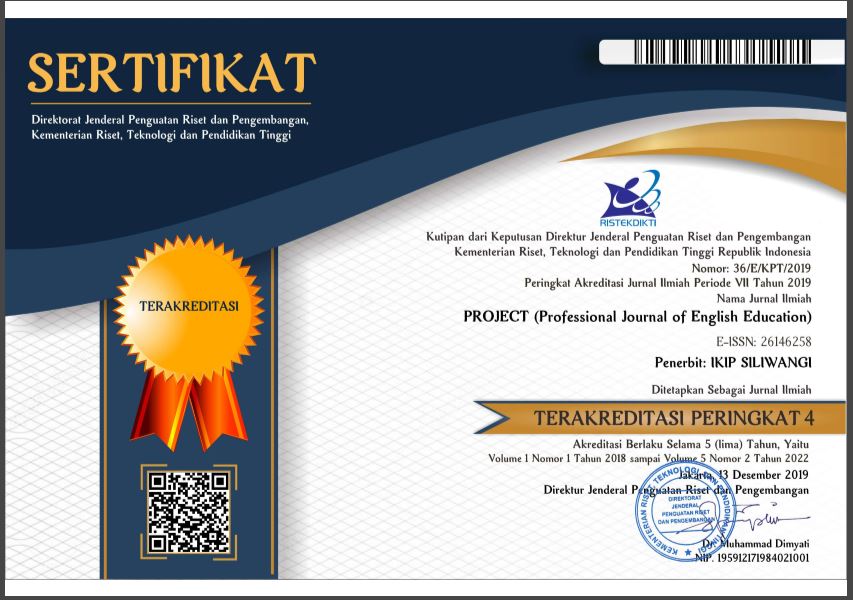NONVERBAL COMMUNICATION CUES OCCURRENCES IN ENGLISH JOB INTERVIEW
DOI:
https://doi.org/10.22460/project.v6i3.p509-515Abstrak
Language and nonverbal communication play a significant role in a job interview. While a candidate uses English to elaborate their answer to the questions given by the interviewer, nonverbal communication delivers a signal to the interviewer regarding the candidate’s personality, behavior, and attitude. The current study explored the occurrences of nonverbal communication cues in an English job hotel interview by applying qualitative study design. The study gathered the data from three informants who work in hotel’s human resources department. The data were gathered through interview and were analyzed using qualitative analysis method, including data reduction, data display, and conclusion drawing. The result of the study revealed that many candidates use some nonverbal communication cues during the English interview, including body language and gestures, facial expressions, eye contacts, and voice tones. These cues helped the interviewer to gain better interpretation toward the candidate’s answers. Therefore, in attending an English job interview, candidates should be aware of the nonverbal communication knowledge.
Â
Keywords:Â English; Job Interview; Nonverbal Communication Cues
Referensi
Abdumutalibovich, K. M. (2022). The Lingua-Pragmatic and Methodological Aspects of Nonverbal Means. Pindus Journal of Culture, Literature, and ELT, 9, 110–114.
Aleksandrovna, S. M. (2021). Cultural Aspect of Non-Verbal Means of Communication. Eurasian Journal of Academic Research, 1(1), 370–373. https://doi.org/10.5281/zenodo.4717588
Anuradha, & Singh, S. N. (2020). Impact of Nonverbal Signals in Business Communication. UGC Care Journal, 43(4), 60–65.
Hashmi, M., & Waheed, M. (2020). Discerning Goodness via Nonverbal Cues: Perspectives from Highcontext Cultures. Journal of Intercultural Communication, 20(3), 74–88.
Hurley, R. S., Sander, J., Nemeth, K., Lapin, B. R., Huang, W., & Seckin, M. (2021). Differential Eye Movements in Verbal and Nonverbal Search. Frontiers in Communication, 6(September). https://doi.org/10.3389/fcomm.2021.654575
Hussein, B. A., & Mahmood, R. K. (2020). The Types of Nonverbal Communication Cues with Reference to Refugeeism. Journal of University of Raparin, 7(2), 159–182. https://doi.org/10.26750/vol(7).no(2).paper8
Jia, M., & Cheng, J. (2021). Emotional Experiences in the Workplace: Biological Sex, Supervisor Nonverbal Behaviors, and Subordinate Susceptibility to Emotional Contagion. Psychological Reports, 124(4), 1687–1714. https://doi.org/10.1177/0033294120940552
Kidwell, B., & Hasford, J. (2014). Emotional Ability and Nonverbal Communication. Psychology & Marketing, 31(7), 526–538. https://doi.org/10.1002/mar.20714
King, J. P. J., Loy, J. E., Rohde, H., & Corley, M. (2020). Interpreting Nonverbal Cues to Deception in Real Time. PLoS ONE, 15(3), 1–25. https://doi.org/10.1371/journal.pone.0229486
Lombardi, M., Warren, W. H., & di Bernardo, M. (2020). Nonverbal Leadership Emergence in Walking Groups. Scientific Reports, 10(1), 1–11. https://doi.org/10.1038/s41598-020-75551-2
Miles, M. B., Huberman, A. M., & Saldana, J. (2014). Qualitative Data Analysis. In Qualitative Data Analysis. Sage Publications. https://doi.org/10.7748/ns.30.25.33.s40
Mosa, R. A. (2021). the Nonverbal Communication and Its Influence on Customer Perceptions Towards Service Encounter: an Empirical Study in the Iraqi Banking Service. European Journal of Management and Marketing Studies, 7(1). https://doi.org/10.46827/ejmms.v7i1.1200
Muhammad, H. A., & Mahmood, R. K. (2021). A Pragmatic Analysis of Proxemics as A Nonverbal Communicator with Reference to The Concept of Social Distancing During Covid-19 Pandemic. ZANCO Journal of Humanity Sciences, 25(5). https://doi.org/10.21271/zjhs.25.5.20
Nagy, E., Farkas, T., Guy, F., & Stafylarakis, A. (2020). Effects of Handshake Duration on Other Nonverbal Behavior. Perceptual and Motor Skills, 127(1), 52–74. https://doi.org/10.1177/0031512519876743
Novotny, E., Frank, M. G., & Grizzard, M. (2021). A Laboratory Study Comparing the Effectiveness of Verbal and Nonverbal Rapport-Building Techniques in Interviews. Communication Studies, 72(5), 819–833. https://doi.org/10.1080/10510974.2021.1975141
Pereira, M., & Hone, K. (2021). Communication Skills Training Intervention Based on Automated Recognition of Nonverbal Signals. Conference on Human Factors in Computing Systems - Proceedings, May, 1–15. https://doi.org/10.1145/3411764.3445324
Rezer, T. (2021). Nonverbal Communication In Public Administration: Modern Challenges. Knowledge, Man and Civilization - Proceedings of International Scientific Congress «Knowledge, Man and Civilization» (ISCKMC 2020), 22-25 October, 2020, Complex Scientific Research Institute Named after H.I. Ibragimov of the Russian Academy of Sciences, R, 107, 2816–2822. https://doi.org/10.15405/epsbs.2021.05.373
Samara, I., Roth, T. S., Nikolic, M., Prochazkova, E., & Kret, M. E. (2022). Can Third-party Observers Detect Attraction in Others Based on Subtle Nonverbal Cues? Current Psychology, 0123456789. https://doi.org/10.1007/s12144-022-02927-0
Shadaydeh, M., Muller, L., Schneider, D., Thummel, M., Kessler, T., & Denzler, J. (2021). Analyzing the Direction of Emotional Influence in Nonverbal Dyadic Communication: A Facial-Expression Study. IEEE Access, 9, 73780–73790. https://doi.org/10.1109/ACCESS.2021.3078195
Whitehouse, J., Milward, S. J., Parker, M. O., Kavanagh, E., & Waller, B. M. (2022). Signal value of stress behaviour. Evolution and Human Behavior, 43(4), 325–333. https://doi.org/10.1016/j.evolhumbehav.2022.04.001
Zand, S., Baradaran, M., Najafi, R., Maleki, A., & Golbazi Mahdipour, A. (2020). Culture and Gender in Nonverbal Communication. Rooyesh-e- Ravanshenasi Journal(RRJ), 8(12), 123–130. http://frooyesh.ir/article-1-1867-en.html




